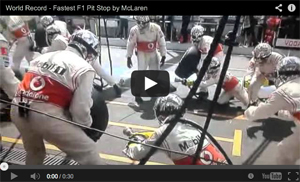 How long does it take you to change a tire on your car or truck? Less the time I spend stewing and mumbling under my breath, it takes me awhile. I chock the wheels, get out the jack, then review the jack instructions because I can’t remember how it works. Typically, I bloody my knuckles and, within minutes, give up. I call roadside service and wait for the experts.
How long does it take you to change a tire on your car or truck? Less the time I spend stewing and mumbling under my breath, it takes me awhile. I chock the wheels, get out the jack, then review the jack instructions because I can’t remember how it works. Typically, I bloody my knuckles and, within minutes, give up. I call roadside service and wait for the experts.
In auto racing, pit stops are where teams make up time on their competitors – or where they lose time and, sometimes, lose the race. In Formula 1 racing, the standard for a 14-person pit crew to swap four wheels and tires is under three seconds. The world record, set in July 2012 by the McLaren team at the Grand Prix race in Hockenheim, Germany, is 2.31 seconds. Watch the video above to appreciate their practiced perfection.
The BBC broadcast a terrific story on how two Formula 1 teams use technology to assess pit team performance and identify different approaches to accomplish pit stop activities in the most efficient ways. One team stated that their pit crews practice wheel and tire changes 100 times during race weekends. They practice perfection. They film every practice session in high definition, slow motion. The video provides feedback that can improve the performance of every team member. They review the tape, clarify opportunities for working more efficiently together, praise progress, and practice again. And again.
McLaren implemented a live pit area dashboard that enables every player, from driver to crew member to team lead, to see the status of every activity during the stop. The 12″x12″ panel of lights shows red if an activity is not done, yellow if the activity is in process, and green if it’s done. For example, the wheel nut wrench (which unlocks and locks the single nut that holds the wheel on the axle) has a button on it that the crew member presses when the wheel is locked on and ready. Pressing the button turns the dashboard light green for that wheel.
Each pit crew member has the responsibility to 1) do their assigned job perfectly and quickly, and 2) press their button to ensure all other team members see their job is done right by the panel’s green light. All in less than three seconds.
Does Your Team Practice Working Cooperatively?
Most work teams don’t “practice perfection” in working together. In fact, most work teams don’t practice at all – nor do most teams have a formalized team “constitution,” with clear purpose, values, strategies, and goals.
Your team can’t practice perfection until they all understand the team’s “reason for being” – and fully buy into it, individually. With committed, talented team members in place, you can then invite staff to analyze what a “great job looks like,” what world class performance looks like. With that standard in place, it’s a matter of investing time identifying key gaps, building better approaches, then practicing those approaches.
Learn from McLaren – help team members perform their tasks perfectly and cooperatively, and you’ll see team performance and engagement grow.
Join in the conversation about this post/podcast in the comments section below. Do your teams practice working together? What elements of a team “constitution” are in place – and how do they help your team’s performance and engagement?
What is it like to live in your organization’s culture? Share your experiences in my fast & free Performance-Values Assessment. Results and analysis are described on my blog site’s research page.
This research can help you refine your organization’s corporate culture. Contact me to discuss conducting the Performance-Values Assessment in your company.
![]() Podcast – Listen to this post now with the player below. Subscribe via RSS or iTunes.
Podcast – Listen to this post now with the player below. Subscribe via RSS or iTunes.
The music heard on these podcasts is from one of Chris’ songs, “Heartfelt,” copyright © Chris Edmonds Music (ASCAP). Chris plays all instruments on these recordings.


